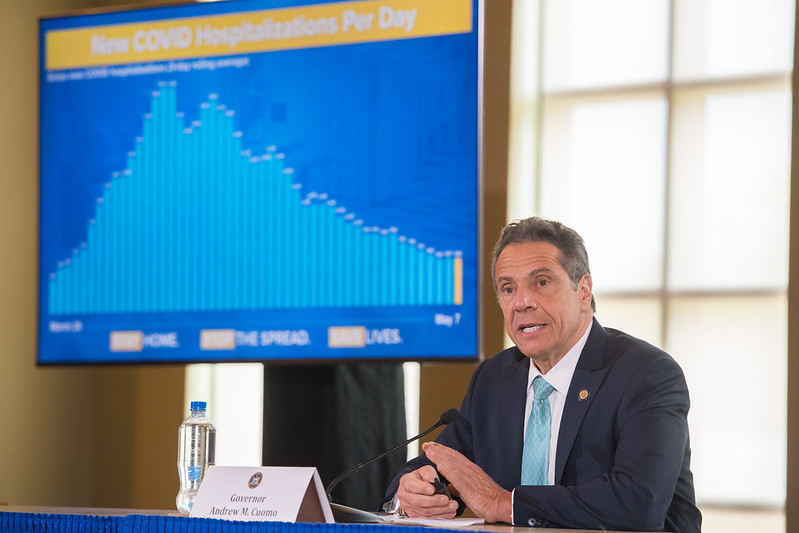
(photo: governor's office)
WHEREAS, Open Data Can Make New York Government More Transparent and Accountable in Order to Promote Public Trust and Save Lives During the COVID-19 pandemic...
Something close to this is the preamble to Governor Cuomo’s 2013 Executive Order 95, which created the state’s open data program almost simultaneously with New York City’s pioneering Open Data Law. What does open data have to do with a massive pandemic and economic shutdown? Well, just about everything.
The COVID-19 pandemic has highlighted the importance of public trust in government. Fortunately, New Yorkers have overwhelmingly heeded the governor’s and mayor’s mandates to socially distance and wear face coverings. This basic trust has slowed the virus in New York and saved lives. Unfortunately, there is a long way to go before New Yorkers have seen the last of COVID-19. The New York Times just reported the Centers for Disease Control is internally predicting a massive increase nationally in COVID-19 cases and fatalities in late May and June.
New York is not an island. As long as COVID-19 cases are skyrocketing nationally, we will be at high risk of reinfection. Given how much death, misery, and economic suffering we have already experienced, it will require great trust and patience with our state and city governments for the public to keep heeding inconvenient and onerous public health rules. We must have trust in governments’ ability to test, track, and report to us.
One important way New York can earn public trust is to open up the huge amounts of data related to COVID-19.
Last month, Reinvent Albany, BetaNYC, and six other watchdog groups sent a letter to the governor asking that all of the state’s data on COVID-19 be placed in the open data portal (a separate letter from seven groups went to the Mayor asking the same). New York State and City’s COVID-19 pages provide more data than most other governments, but they provide very little open data – data that is downloadable, sortable, and machine-readable. Despite all the charts on the New York state COVID-19 tracker, only a single dataset is provided in the state’s open data portal, whereas none of the city’s Department of Health and Mental Hygiene (DOHMH) data is centralized on the city’s open data portal.
Withholding open datasets creates an unnecessary burden for the public and sows doubt. If someone wants to analyze the data on New York state’s COVID-19 page, they must go through the tracker and enter all of the numbers into a spreadsheet manually. Some datasets – such as deaths by date – aren’t even provided in the tracker and can only be found in the governor’s daily powerpoint presentations. Likewise, too many of the city’s datasets are only available in PDF format, with some open data on GitHub, meaning that most city data also requires manual formatting. Both the state and the city could remove this time-consuming process by simply opening up all of the data on COVID-19. How can we trust the government's response if it isn't sharing data in an accessible way?
Both New York State and City need to make all of this information available in their Open Data portals, and the datasets must be as granular as possible, with discrepancies addressed and logged. The state should be sharing county-level data. The city should be sharing data down to the Neighborhood Tabulation Area (NTA) – the same level of data the DOHMH shares about 100 other measures via the New York City Neighborhood Health Atlas. There are legitimate concerns about the need to protect New Yorkers’ privacy during this crisis, but the DOHMH has a simple process for sanitizing the data to ensure civil liberties aren’t violated.
Releasing New York’s COVID-19 data will be crucial to prepare for second or third outbreaks, which experts say are likely to occur over the next year. To prevent more tragedy, New York will need to know where the virus travels, whom it is affecting, how it is getting there, and who is most at risk. This doesn’t mean that the city should limit its datasets to in-house experts – instead, the data should be opened up so that the informed public can share its own analysis and insight rather than being restricted to official narratives.
Open data is key for building public trust in government. Seeing how our governments are operating enables the public to better understand its operations. Trust is what gives government the latitude to do more good work. Times of crisis may seem to make open data less of a priority, but these times are in fact when open data is needed the most.
***
John Kaehny is executive director of Reinvent Albany. Noel Hidalgo is executive director of BetaNYC. On Twitter @JohnKaehny & @ReinventAlbany & @noneck & @BetaNYC.
***
Have an op-ed idea or submission for Gotham Gazette? Email This email address is being protected from spambots. You need JavaScript enabled to view it.




